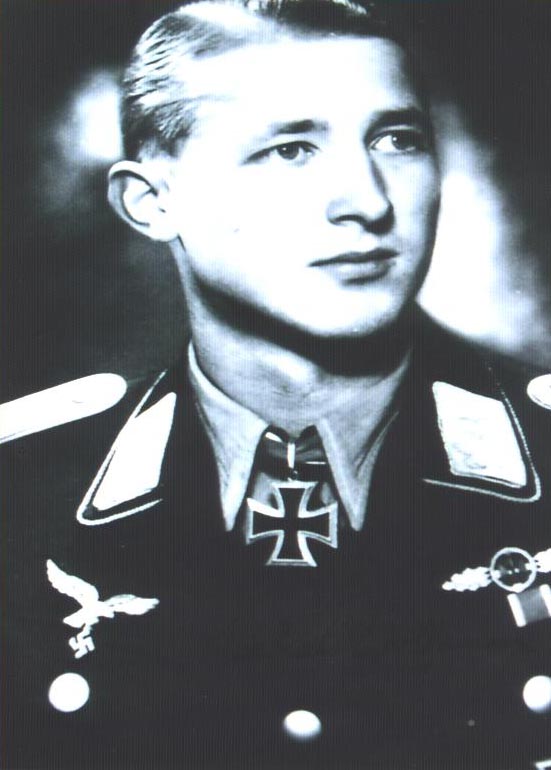
|
WOLFRUM Walter
Oberleutnant
Wolfrum, Walter
* 23.05.1923 Schmölz/Oberfranken
+ 26.08.2010 Schwabach
Awarded Knights Cross 27.07.1944
as: Leutnant Flugzeugführer 5./JG 52
Son of an evangelical minister, I entered the Luftwaffe in October 1940 as a volunteer. I began flying training at the Air Warfare School at Berlin, making my first solo flight in the Fw 44 “Stieglitz”. I made my first flight on the
Me 109B at Bad Aibling in August 1942. The following November I was transferred to the Operational Training Unit at St Jean d’Angely, France, flying the Me 109F-2 and F-4.
In February 1943, I transferred to the Crimea for duty with 5./JG 52, part of II. Gruppe, at the time commanded by Hauptmann Steinhoff. In March, we moved to the “Cuban Bridgehead” where I flew my first missions. Like every other young fighter pilot, the first four to six weeks were the worst, due to my own lack of experience and, therefore, I was very much in the care of the more experienced pilots in that early period. At that time we were in combat with Lagg 3, Yak 1 and P-39 Airacobra fighters and also II 2 and Douglas Boston bombers. On a single day in May 1943, the pilots of JG 52 shot down 80 aircraft over the Noworossisk battle area.
In June 1943, after about 50 missions I achieved my first aerial victory, having already been shot down three times and wounded twice. After double this number of operations, I began to feel halfway experienced and thus was able to start increasing my total of victories. In late 1943, we returned from the battlefields of Charkov, Muis, Poltava and Kiev to the Crimea, where I had first started operations. The following April, I achieved my 70th victory over Sevastopol, but was again wounded in the process. Returning from hospital a month later, I took command of 1 Squadron on the northern Romanian Front where, on 30 May 1944, I had my most successful day, with 11 aerial victories. During this period I also flew operations protecting the Ploesti oilfields from American B-17 and B-24 bombers, with their accompanying Mustang protection.
In June 1944, my I. Gruppe was transferred to southern Poland, scene of the massive Russian offensive against Lemberg. The massed formations of enemy aircraft which took part were like nothing I had ever seen before. On 16 July 1944, I flew four missions shooting down ten aircraft but was again wounded when a cannon shell from a P-39 passed through my stomach and entered my pelvis. A six month stay in hospital followed.
Returning to the Front in February 1945, now in the rank of Oberleutnant, I resumed command of my old LUG 52, and achieved another 11 victories before the war ended.
The most significant unit for me was my first, 5./JG 52, where, as a student, I was moulded into an experienced fighter pilot. The first to take me under his wing was my Squadron commander, Leutnant Haberda, who sadly fell from a direct flak hit after only a few weeks. His successor was Oberleutnant Zwernemann, an Oak Leaves holder and great Ace. I also received help from Feldwebel (later Oberleutnant) Fonnekold who, in my eyes, was a virtuoso fighter pilot.
For a while, I was fortunate to fly as wingman to my Gruppenkommandeur, Hauptmann Gerhard Barkhorn, who achieved his high victory score through unbelievable tenacity. Like a terrier, he would sink his teeth into his opponent until he was finished off. When my Kommodore, Oberstleutnant Hrabak, transferred me from 5./JG 52 to assume command of 1 Squadron, I was sorry to have to leave such an excellent squadron.
In total, I had flown 423 missions, achieved a total of 137 aerial victories, of which 119 were over fighters and I was also credited with sinking a gunboat. I had been wounded four times, had to carry out 12 emergency landings, and had been awarded the Knight’s Cross and German Cross in Gold.
When the war ended, on 8 May 1945, my unit was on the Deutsch-Brod Airfield in Czechoslovakia and it was from here that we surrendered to the Americans. After three weeks in a prison camp, the whole of JG 52 was handed over to the Red Army. I was released the following month because of the severity of my injuries, but many of my compatriots did not return for another ten years. I later devoted myself to aerobatic flying and, in 1962 became the German National Champion.
aircraft flown in combat
On operations, I exclusively flew the Me 109, mainly the G model, but later also the K. The G-2 to G-6 models all had the same engines and therefore had similar performance, but the G-10 and K-4 had the more powerful DB605D engine with 2,000 hp and better performance. I preferred the G-10 with its 2 cm motor cannons, but thought less of the K-4, equipped with the heavy 3 cm slow firing cannon, which had a very curved trajectory and was prone to jamming in high “g” turns.
I was not keen on the types with under-slung weapons, since they restricted the aircraft’s speed, rate of climb and manoeuvrability at a time when the Me 109’s performance was already starting to fall behind its Allied counterparts. We called these the “cannon boats”.
The best Allied fighter aircraft I fought against were the American P-51s at high altitudes, and the Soviet Lagg 7s and the lightly constructed Yak 3s at lower altitudes.
Postwar autographed photo measuring 4' x 51/4"
Price: $20.00
Please contact us before ordering to confirm availability and shipping costs.
Buy now with your credit card
other ways to buy
|


